Mexico › Visiting Teotihuacan
Updated: March 7, 2022
See Also
- Best Places to Stay in Mexico City
- Best Time to Visit Mexico City
- Mexico City Itineraries
- Best Restaurants in Mexico City
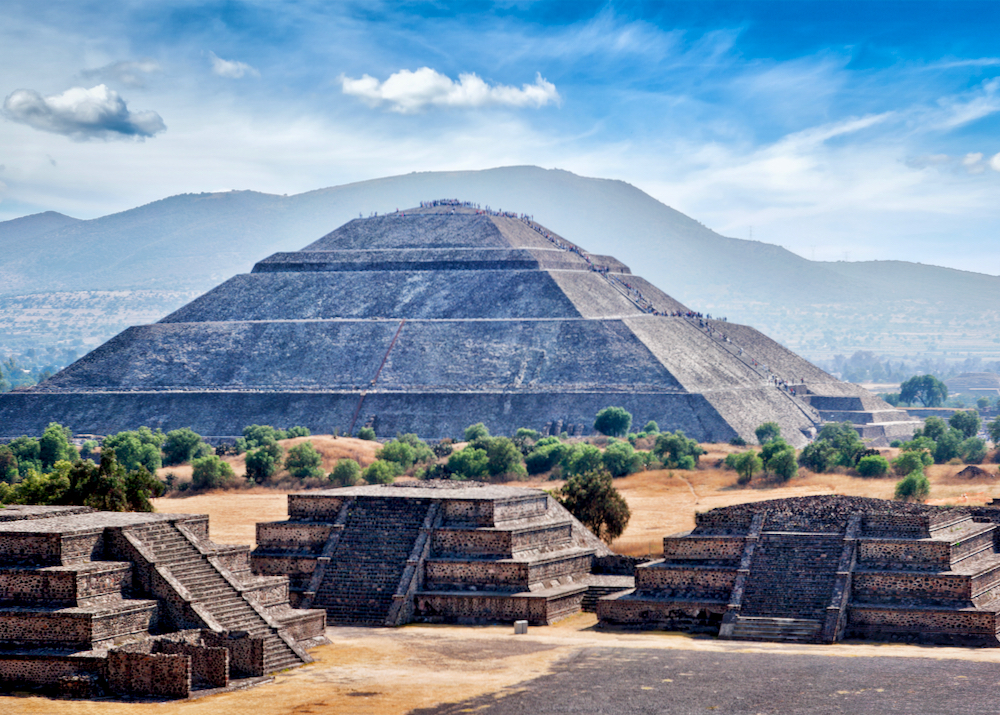
Teotihuacan is a UNESCO World Heritage Site. It includes some of the world’s tallest pyramids, one of the most spectacular archeological sites in Mexico, and also one of the most easily accessible.
Visiting Teotihuacan – Tips & Info
- The ruins are open daily 9am to 5pm and cost 80 pesos to visit.
- There are five entry gates (“puertas”), but buses (and most visitors) aim for Puerta 1 or 2.
- Aim to arrive at Teotihuacan just before opening time at 9am – this is by far the busiest Mesoamerican site in Mexico, so it pays to get an early start
- Allow around at least half a day to visit the ruins – aim to eat lunch here if possible.
- Hire an official guide (once inside the entrance), or obtain a comprehensive written guide before touring the site, as there are very few signs in English.
- Guides charge around 850 pesos for a 1 to 2 hours and 1500 pesos for a 2 to 3 hours. Non-Spanish speakers should make sure the guide’s English is good before paying.
- Local vendors sell snacks, drinks and handicrafts outside and inside the site – bring peso cash for these.
- Note that it is permitted to leave the site for lunch and re-enter with your original ticket (see below for eating suggestions).
- You can climb the Teotihuacan pyramids (only halfway up the Pyramid of the Moon), but numbers are restricted and lines form for the Pyramid of the Sun soon after opening at 9am. It’s a short but energetic hike to the top, aided by support ropes, but visitors with mobility or fitness issues may have problems..
The main attractions at Teotihuacan are the monumental pyramids along the 2 km “Calzada de los Muertos”, the Causeway of the Dead. The Pyramid of the Sun (“Pirámide del Sol”) is a gargantuan, 70-meter high structure with sensational views of the whole site from the top. The similar Pyramid of the Moon (“Pirámide de la Luna”) at the end of the Calzada de los Muertos is slightly smaller but provides the best overview of the site’s overall layout (though it’s only possible to climb as far as the platform half way up).
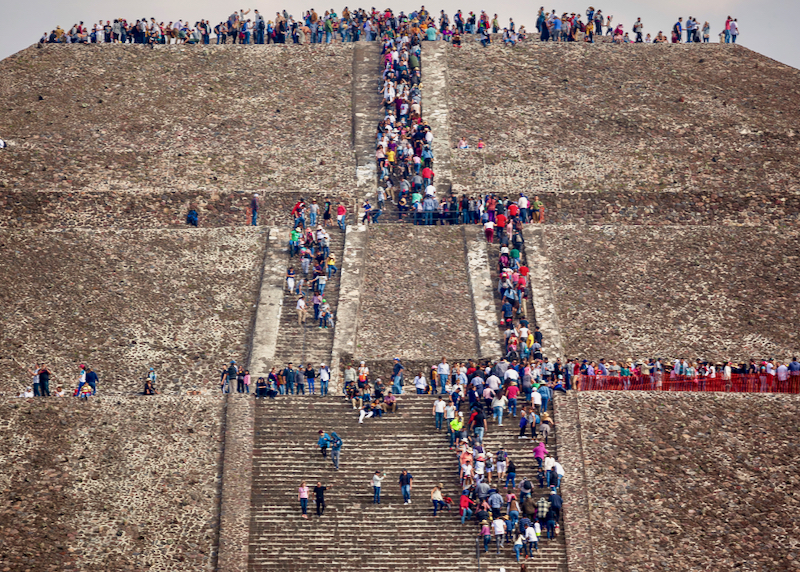
Visitors are allowed to climb the stairs to the top of the Pyramid of the Sun, one of the two largest at Teotihuacan.
Other highlights include the Palacio de Quetzalpapálotl, an artfully restored palace with finely carved pillars and original frescoes. Opposite Gate 1 (Puerta 1) is La Ciudadela, a huge sunken square, surrounded by stepped platforms, once serving as the city’s administrative heart. The main attraction here is the Temple of Quetzalcoatl, with its four steps featuring ornate bas-relief sculptures.
Be sure to also visit the two site museums, the Teotihuacan Culture Museum (“Museo de la Cultura Teotihuacana” at Puerta 5) and the Museum of Teotihuacan Murals (the “Museo de Murales Teotihuacanos” at Puerta 3A), crammed with precious artifacts discovered at Teotihuacan, from obsidian tools and ornately decorated ceramics, to burials recovered from under the Temple of Quetzalcoatl. The “Ex-Museo” near Puerta 1 is reserved for temporary exhibitions featuring the latest finds at Teotihuacan.
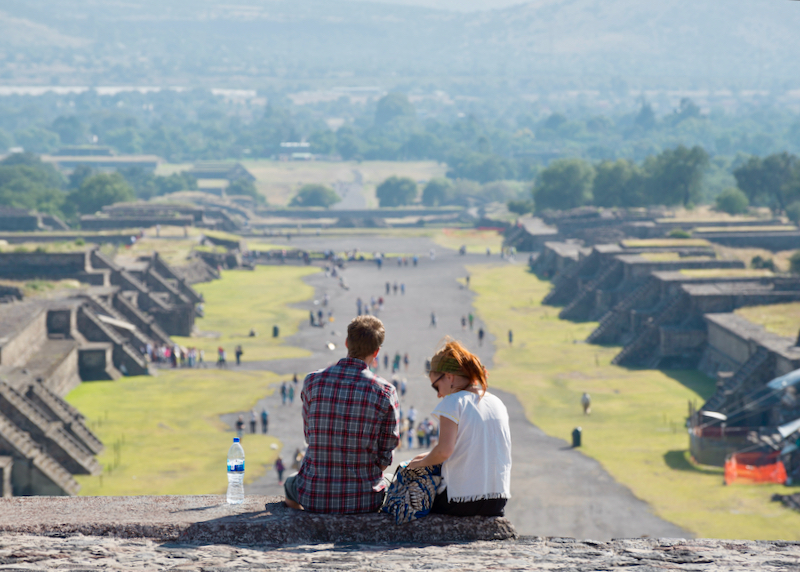
Visitors are allowed to climb half way up the Pyramid of the Moon, which has the best views of the entire complex. ‘The Avenue of the Dead’ is the central spine running through the site.
Frequently Asked Questions about Teotihuacan
Where is Teotihuacan?
Teotihuacan is an ancient Mesoamerican city in central Mexico, located in the federal State of Mexico, in-between the modern towns of San Juan Teotihuacán and San Martín de las Pirámides. It lies some 50 km northeast of central Mexico City.
How big is Teotihuacan?
Teotihuacan covers around 20 square kilometers (8 square miles), though satellite communities are thought to have existed far beyond these boundaries (up to 30 square kilometers). The main tourist site today covers around 2.6 square kilometers (652 acres). At its peak 100,000 to 200,000 people may have lived here. Today around 47,000 people live in the adjacent community of San Juan Teotihuacán.
What is the history of Teotihuacan?
Teotihuacan was one of the largest and oldest Mesoamerican cities, with early communities forming here around 600 BC. The city proper was established during the “Teotihuacan I” phase (200 BC to 1 BC), while the city grew to be the biggest in the Americas in “Teotihuacan II” (1–350 AD). The famous Pyramids of the Sun and Moon were completed in this period. The city reached its peak during “Teotihuacan III” (350–650), when it became the predominant power of ancient Mexico, conquering rivals as far as Copán in modern-day Honduras. “Teotihuacan IV” marks the decline of the city between 650 and 750. The reasons for this are still debated, ranging from internal unrest (civil war), to ecological collapse (droughts). Small communities remained among the ruins however, and during the heyday of the Aztec Empire in the 15th century Teotihuacan was a sacred place of pilgrimage, the place where the sun was born. Major excavations and research began in 1905, and the city became one of the first Mesoamerican sites to be developed for tourism. Discoveries are still being made – excavation of a tunnel beneath the Temple of the Feathered Serpent began in 2010 and took several years.

Amazing stone work and carvings at the Pyramid of Venus.
How do I get to Teotihuacan?
Most tourists visit Teotihuacan on day-trips from Mexico City. Taking an organized tour (with transport by bus included, from around 900 pesos) is the most convenient option and is easy to arrange at hotels in the city, but it’s also relatively straightforward to visit independently – a far cheaper option, and allowing more flexibility. Buses depart Mexico City’s Terminal del Norte (“Autobuses del Norte” metro stop, Line 5), every 20 minutes or so through the day to Teotihuacan via Autobuses Teotihuacan (www.autobusesteotihuacan.com.mx). It takes around 1 hour and costs around 110 pesos return. It’s usually a little faster to take the Metro to the Indios Verdes station (line 3) and take a bus to “Las Pirámides”.
Regular taxis in Mexico City are likely to charge well over 1000 pesos for the trip to Teotihuacan – take an Uber or the bus.
Amigo Tours is a recommended operator for guided tours of Teotihuacan – they offer early access tours which arrive before most of the other tour groups (amigotours.com.mx/mexico-city/sunrise-tour).
What about Uber?
Uber is available in Mexico City – one-way rides to Teotihuacan from the Zócalo in the center of Mexico City cost around 490 pesos.
Can I drive to Teotihuacan?
It’s relatively straightforward to drive to Mexico City from the US (it’s 590 miles/950 kilometers from Brownsville, Texas), but this not recommended. The Mexican border states of Nuevo León and Tamaulipas have been affected by drug cartel violence, and the roads in and around Mexico City are heavily congested and confusing to navigate. It’s also possible to rent a car once here and drive to Teotihuacan from Mexico City, but it’s much easier to take a bus or a guided tour, especially for first-time visitors.
Do I need a car in Teotihuacan?
No. The site itself is pedestrian only and small enough to explore on foot.
When is the best time to go to Teotihuacan?
Teotihuacan is a year-round attraction, but the best time to visit is during the dry season, from November to April – nights can be cold, but during the day it’s likely to be sunny and warm (especially March and April). Summers tend to be hotter and rainy. Aim to arrive early to beat the crowds; avoid Sundays and Mexican public holidays altogether, when the site is mobbed with visitors and long lines are common to climb the pyramids.
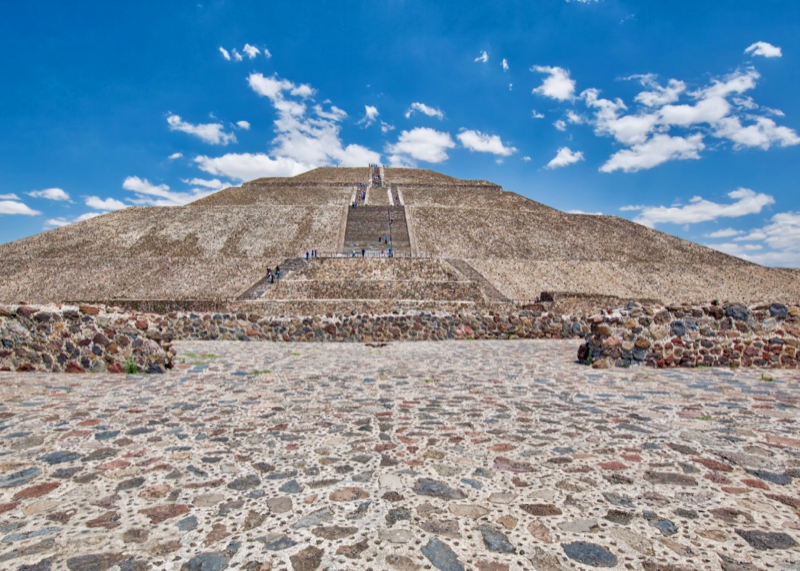
The massive stone plaza in front of the Pyramid of the Sun.
Where should I stay in Teotihuacan?
Most people visit Teotihuacan on a day-trip from Mexico City. Visit our Best Places to Stay in Mexico City guide for more info. It is possible to stay next to the ruins, which can make it easier to get an early start – our favorite is the Villas Teotihuacan Hotel Spa, within walking distance of Gate 1 (Puerta 1), with basic but adequate rooms and swimming pool.
What are the best things to do in Teotihuacan?
There’s only one reason to come here – the ancient ruins of Teotihuacan (officially “Zona Arqueológica de Teotihuacan”).
What are the facilities like?
Tickets are sold at each of the five entrances to the site, though toilets are only available at gates 1,2, 3 and 5. Gate 3 is the only accessible entrance (with ramps and walkways for wheelchairs). An official INAH bookstore at Gate 5 sells maps and guidebooks to the site. Souvenir and handicraft shops cluster around each entrance, and official guides are available for hire at all five gates.
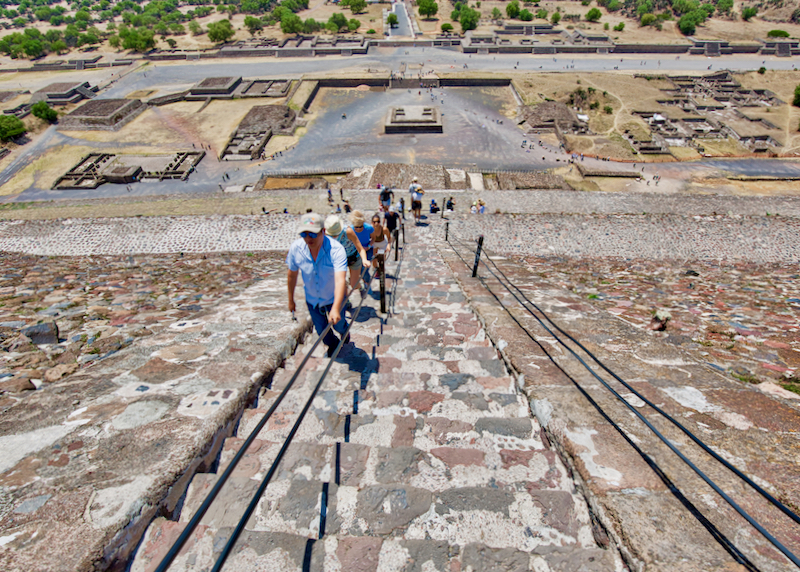
Climbing the steps of the various pyramids in challenging and fun.
What about food?
It’s worth exiting the site to eat at one of the restaurants just beyond the gates (it’s permitted to re-enter afterwards). Our favorite is La Gruta (200m west of Puerta 5), a fine restaurant charmingly located in an open-sided cave, with traditional dance performances and typical Mexican food. Las Pirámides, the official restaurant at Puerta 1, offers the best views of the pyramids and fairly decent Mexican food, as well as three-course set menus.
What currency is used in Teotihuacan?
The Mexican peso (often pre-fixed with a “$” sign) is the currency of Mexico and used in Teotihuacan – vendors in and around the site will often accept US dollars (albeit at poor exchange rates), though entry to the site itself will be paid in pesos.
Bring lots of peso cash for small purchases like bottled water and snacks.
Is Teotihuacan safe?
Yes. Teotihuacan itself has avoided the drug violence that has affected other parts of Mexico, and is generally free of petty crime.
Read More
- Cancun – Best Hotels
- Cancun – Family Hotels
- Isla Mujeres – Best Hotels
- Isla Mujeres – Family Hotels
- Los Cabos – Travel Guide
- Los Cabos – Best Hotels
- Los Cabos – Family Hotels
- Mazatlan – Best Hotels
- Mazatlan – Family Hotels
- Playa del Carmen – Best Hotels
- Playa del Carmen – Family Hotels
- Puerto Vallarta – Best Hotels
- Puerto Vallarta – Family Hotels
- Punta de Mita – Best Hotels
- Sayulita – Best Hotels
- Tulum – Best Hotels
- Tulum – Family Hotels